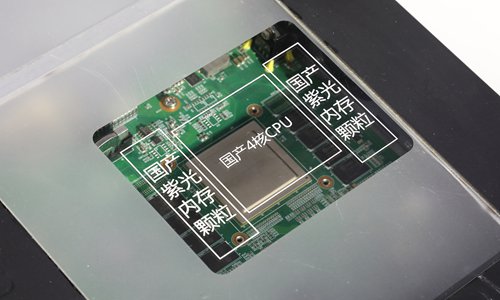
A view of the 32-layer 3D NAND flash chip developed by YMTC Photo: IC
A Chinese research institute has made a breakthrough in a new type of 5 nanometer (nm) laser lithography technology, which industry insiders believe could lay the foundation for research into a self-developed advanced lithography machine, a field in which China lags behind some developed Western countries.
But they stressed that China remains "far away" from producing such a chip-making machine as there are still technological barriers. Lack of sufficient capital also presents an obstacle to translate the theoretical findings into production power.
The Suzhou Institute of Nano-tech and Nano-Bionics under the Chinese Academy of Sciences (Sinano), along with the National Center for Nanoscience and Technology, announced Thursday that they have made important progress on ultra-high precision laser lithography, according to a statement on Sinano's website.
The new tech has broken the traditional constraint in laser direct writing to be able to process at nano-level. The ultra high precision processing is based on a new type of three-layer membrane structure.
In addition to high precision, the technology demonstrates the potential of mass production. The laser direct writing tech could be used to produce up to 500,000 special nano electrodes an hour.
The research result is published in Nano Letters, a monthly peer-reviewed scientific journal published by the American Chemical Society. The paper noted that the new nano processing technology could be widely applied in such sectors as semiconductors, photonic chips and micro electro mechanical systems.
Xiang Ligang, a Beijing-based veteran industry analyst, told the Global Times on Thursday that the new technology will equip Chinese researchers with the theory to make forays into making homegrown lithography machines. "But it will take years for China to close the gap with the advanced Western suppliers, in particular ASML," Xiang said.
ASML delivered 7nm EUV lithography machines last year. The Netherlands-based firm also announced in June that it has made a significant development in its multi-beam inspection tool line for 5nm lithography machines.
In China, Shanghai Micro Electronics Equipment (SMEE) announced in June that it expects the first China-made 28nm immersion type lithography machine will be delivered in 2021-2022. SMEE has mass-produced lithographs with the best performance of 90nm processing nodes.
Xiang noted that the Dutch firm monopolized key technologies in making lithography machines, which makes it difficult for Chinese companies to fast track their production. "It's urgent to improve the machines' production yield," Xiang noted.
Industry observers noted that another critical issue lies in the absence of sufficient capital input due to the slow return on a heavy investment.
"Chinese research institutes need to work with companies to translate theories into products. But in terms of profits, making a chip-production machine could cost billions of yuan and it will take years to recover the investment. Most Chinese companies don't see it as a good deal," Xiang explained.
China accounts for one-third of global semiconductor sales, according to media reports. The recent US-led relentless attack on China's high-tech industries, which could cut off some Chinese tech companies like Huawei from advanced chip imports, has created a sense of urgency for the world's second-largest economy to be self-sufficient in the semiconductor industry.




